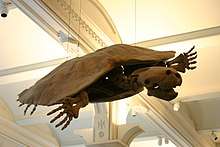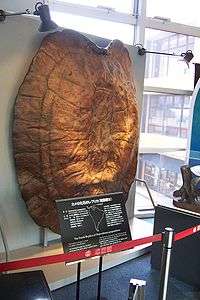Stupendemys
Stupendemys is a prehistoric genus of freshwater side-necked turtle. Its fossils have been found in northern South America, in rocks dating from the Middle Miocene to the very start of the Pliocene, about 13 to 5 million years ago.[1][2]
| Stupendemys | |
|---|---|
 | |
| Stupendemys geographicus at the AMNH | |
| Scientific classification | |
| Kingdom: | Animalia |
| Phylum: | Chordata |
| Class: | Reptilia |
| Order: | Testudines |
| Suborder: | Pleurodira |
| Family: | Podocnemididae |
| Genus: | †Stupendemys Wood, 1976 |
| Species | |
| |
Description
A nearly complete fossil of Stupendemys's carapace measured over 2.35 m (7.7 ft) in length and was also very wide.[3] Based on this specimen, a larger but less complete fossil carapace would have had an estimated total carapace length of more than 3.3 m (11 ft), making it one of the largest turtles that ever existed, rivaling even Archelon.[3] The largest freshwater turtle living in the Neotropics today is the Arrau turtle (Podocnemis expansa), a pleurodire closely related to Stupendemys, but the Arrau turtle measures only 75 centimetres (30 in).[4] Males of S. geographicus have a pair of horns present on either side of the carapace around the neck opening. These horns are deeply grooved, suggesting that they were the covered by a keratinous sheath. These were presumably used for combat between individuals, as similar behaviour is known in extant species.[5]
Taxonomy
Two species have been described to date. Stupendemys geographicus was more robust; its remains have been found in the Urumaco Formation of Venezuela and in the Villavieja Formation of Colombia.[5] Stupendemys souzai, marginally smaller and more slender, was recovered from the Solimões Formation in Acre State, Brazil.[2][6] However, these are currently considered part of S. geographicus, alongside remains described as Caninemys tridentata from Brazil and Podocnemis bassleri from Peru.[5]
Ecology

Its weight helped Stupendemys stay under water for extended periods of time, grazing on aquatic plants. On the other hand, it was probably a very weak swimmer, unable to move its bulk against a swift current, and thus probably avoided smaller streams.[2]
S. geographicus inhabited what is known as the Pebas system, a large wetland system that dominated northern South America during the Miocene.[7] The wetlands seemed to have favoured gigantism in other aquatic animals, like the crocodylian Purussaurus and rodent Phoberomys.
Its growth rate is similar to extant turtles, suggesting a lifespan of perhaps 110 years to get to maximum size.[5]
Thought its diet was previously interpreted as carnivorous, though a well preserved jaw indicates it might have had a more generalist diet, possibly durophagous or including fruit.[5]
Since S. geographicus fossils have been found in sites which yield a rich fossil fauna, even though little is known with certainty, much can be inferred about the ecology of these animals. Among the aquatic animals that shared the habitat with S. souzai were fish, including catfish such as Phractocephalus and Callichthyidae, characids such as Acregoliath rancii and the tambaqui (Colossoma macropomum), the South American lungfish (Lepidosiren paradoxa), trahiras (e.g. Paleohoplias assisbrasiliensis) and freshwater rays and sharks. Crocodilians were diverse and abundant, among them such taxa as Charactosuchus fisheri, Gryposuchus, Mourasuchus, Nettosuchidae and the giant Purussaurus brasiliensis. Other turtles and tortoises found in the same deposits are Chelus columbiana[8] (a prehistoric relative of the mata mata) and Chelonoidis. Further aquatic vertebrates included river dolphins and the large darter "Anhinga" fraileyi.[2]
Terrestrial mammals were plentiful, and the fauna included many megaherbivores, like the ground sloth Acremylodon campbelli, Toxodontidae (e.g. Gyrinodon and Trigodon), Proterotheriidae, and caviomorph rodents, some of them of immense size also (e.g. Kiyutherium, Neoepiblema, Phoberomys burmeisteri, Potamarchus murinus, Telicomys amazonensis and Tetrastylus). Smaller mammals living in that time and place were the ateline monkey Stirtonia and the bulldog bat Noctilio lacrimaelunaris.[2]
Altogether, this fauna is massively dominated by large herbivores and generally lacks terrestrial carnivores. It can thus be assumed that the habitat was mostly low-lying rainforest that was seasonally flooded, as well as floodplains and swampland. The rivers must have been wide and slow-moving, as the fossil-rich rocks are alluvial deposits and do not show evidence of fast-flowing riverbeds that would have dug into the sediment deeply while depositing little of their own.[2]
References
- Wood, R. C. (1976). "Stupendemys geographicus, the world's largest turtle". Breviora. 436: 1–31.CS1 maint: ref=harv (link)
- Bocquentin, Jean; Melo, Janira (2006). "Stupendemys souzai sp. nov. (Pleurodira, Podocnemididae) from the Miocene-Pliocene of the Solimões Formation, Brazil" (PDF). Revista Brasileira de Paleontologia. 9 (2): 187–192. doi:10.4072/rbp.2006.2.02.CS1 maint: ref=harv (link)
- Stupendemys: Giant Amongst Mega-Turtles
- Cox, Barry; Dixon, Dougal; Gardiner, Brian (2001). Dinosaurier und andere Tiere der Vorzeit [Dinosaurs and other prehistoric animals] (in German). Gondrom Verlag. ISBN 3-8112-1138-2.CS1 maint: ref=harv (link)
- Cadena, E.-A.; Scheyer, T.M.; Carrillo-Briceño, J.D.; Sánchez, R.; Aguilera-Socorro, O.A.; Vanegas, A.; Pardo, M.; Hansen, D.M.; Sánchez-Villagra, M.R. (12 Feb 2020). "The anatomy, paleobiology, and evolutionary relationships of the largest extinct side-necked turtle". Science Advances. 6 (7): eaay4593. doi:10.1126/sciadv.aay4593.
- Bocquentin, J.; Guilherme, E. (1997). "A cintura pélvica do quelônio Stupendemys (Podocnemididae, Podocnemidinae) proveniente do Mioceno superior-Plioceno do Estado do Acre, Brasil". Acta Geologica Leopoldensia. 20 (45): 47–50.
- Hoorn, C.; Wesselingh, F. P.; ter Steege, H.; Bermudez, M. A.; Mora, A.; Sevink, J.; Sanmartin, I.; Sanchez-Meseguer, A.; Anderson, C. L.; Figueiredo, J. P.; Jaramillo, C. (2010-11-11). "Amazonia Through Time: Andean Uplift, Climate Change, Landscape Evolution, and Biodiversity". Science. 330 (6006): 927–931. doi:10.1126/science.1194585. ISSN 0036-8075.
- "Giant fossil matamata turtles (matamatas part V)". Archived from the original on 2011-10-11. Retrieved 2011-10-11.